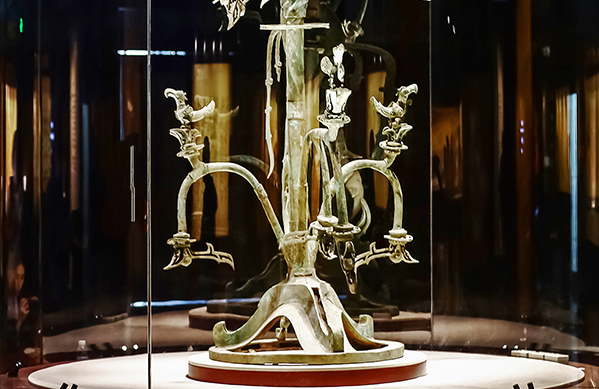Mysterious artifacts of Sanxingdui

The “Divine Tree” No.1 unearthed from the Sanxingdui site in 1986 Photo: CFP
The Sanxingdui ruins site is an outstanding representative of the world’s bronze civilization between the 16th and 14th centuries BCE. The Sanxingdui culture is remarkable as it seems to have developed independently from the other cultures in ancient China, with no similar finds occurring anywhere else. The Sanxingdui culture was unrecorded in historical texts and previously unknown. There is no written record of this culture, leaving scholars uncertain about its origins and its demise. Where did this civilization come from? Archaeologists have made assumptions that sound plausible about the Sanxingdui culture. However, many assumptions contradict current knowledge about Chinese history and civilization.
Gold scepter
A problem with theories that the gold scepter served as a symbol of state power is that there is no evidence linking gold scepters with authority in China’s history. It is the bronze ding, an ancient Chinese cauldron, usually standing upon legs with a lid and two handles, that has long been regarded as the symbol of royal or imperial authority or sovereignty. Some speculate that using a gold scepter as an item of royal insignia might come from the West. However, gold scepters did exist in China’s history, with many uses. Historical texts suggest that during the Northern Wei period (386–534), the Gaoche people, a nomadic tribal confederation living in the north of China and in Central Asia, gave gold scepters as gifts to the ruler of the Central Plain (the area on the lower reaches of the Yellow River which formed the cradle of Chinese civilization). The Gaoche people could date back to before the Spring and Autumn Period (770–476 BCE), and they were also known as Dili. They were called Dingling during the Han Dynasty (202 BCE–220 CE), and Chi Le during the Wei, Jin, Southern and Northern Dynasties (220–589). Historical studies suggest that the Qiang people were the ancestors of the Chi Le. Qiang people lived mainly in the region where the ancient Shu Kingdom was located. Therefore, the gold scepter from the ancient Shu Kingdom might not symbolize royal power, if it had something to do with the Qiang culture.
‘Divine trees’
The Bronze Tree No. 1 is the tallest of the eight bronze sculptures of trees—termed shen shu (“divine trees”) by modern archaeologists— which were excavated from the Sanxingdui site in the late 1980s. Tree No.1 was originally decorated with bronze bells and other bronze ornaments resembling turtle’s shells, scallops, and dustpans. In addition to the nine birds perching at the crest of each downward-curving branch, there are 27 fruits, hollowed-out gold leaves, and jade ornaments on the tree. A bronze dragon is attached to the trunk, which seems to be crawling down the tree. Some archaeologists assume that the trees represent the mythological fusang tree and further assume that these bronze trees were used in ritual ceremonies as the “heavenly ladder” that guided ancestors or divinities.
Masks with protruding pupils
Many bronze masks unearthed from the Sanxingdui site are characterized by exaggerated zong mu (protruding pupils) or almond-shaped eyes.
Some researchers speculate that these masks were inspired by immigrants from the West. Another presumption associates the masks with ancient people’s imaginations. The ancient Chinese often imagined their ancestors with supernatural features. According to a text by Liu Zongyuan (773–819), a Tang Dynasty scholar, the zong mu feature (protruding pupils), is connected to the legends of people who lived in the Shu Kingdom. Hence, the famous protruding pupils on the masks unearthed at the Sanxingdui site might not be derived from real humans, but the legendary images of Shu people’s ancestors.
Sun Shaohua is a research fellow from the Institute of Literature at the Chinese Academy of Social Sciences.
Edited by REN GUANHONG
